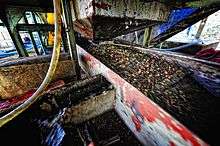Coffee production in Thailand
Thailand (formerly Siam) is one of the top coffee producers in the world as of 2014.[1] The country is ranked third among the coffee producing countries of Asia with robusta coffee accounting for 99 percent of its production.[2]

History
Thailand is a relative late-comer to coffee production. In the 1970s King Bhumibol Adulyadej launched a series of coffee projects in the north to help local communities grow cash crops like coffee as an alternative to growing opium poppies.[2] Thailand became an exporter of coffee in 1976.[3]
Production
In general, Arabica beans are grown in northern Thailand and robusta beans in the south.[3]
Robusta coffee (Coffea canephora) is grown chiefly in the provinces of Chumphon, Surat Thani, Nakhon Si Thammarat, Krabi, Phang Nga, and Ranong. Coffee is cultivated on 67,832 hectares.[2] Coffee production in the southern part of the country is 80,000 tons of robusta coffee. One-quarter of the robusta coffee is for domestic consumption in the form of soluble, roasted, powdered, and tinned coffee.[2]
About 500 tons of Arabica coffee is grown in northern Thailand. Coffee production in the northern border region with Burma and Laos, known as the (Golden Triangle). Arabica coffee is a good variety as its yield is profitable to all categories of farmers, including the hill people.[2] Organic coffee is considered suitable for cultivation in the highlands with an elevation range of 800 metres (2,600 ft) to 1,200 metres (3,900 ft). Coffee is grown both in shaded areas and in open areas in full sun. Intercropping is also practised in hill areas along with fruit trees.[2]
According to FAO statistics for 2013, coffee production was 50,000 tons grown on 51,000 hectares. Yield was 980 kilograms per hectare, which placed it at 18th in the world rankings.[4] In 2015, two types of coffee, Doi Tung and Doi Chang, received protected designation of origin (PDO) status from the European Union. The designation is comparable to those bestowed on "Champagne", "Parma ham", or "Bordeaux".[5]
References
- Total Production of Exporting Countries, International Coffee Organization Archived 2010-07-06 at the Wayback Machine
- Angkasith, Pongsak (January 2002). "Coffee Production Status and Potential of Organic Arabica Coffee in Thailand" (PDF). AU Journal of Technology. Assumption University. Retrieved 7 June 2015.
- Feil, Bryan (2015-11-03). "History of Thailand Coffee". Lanna Coffee Company. Retrieved 8 February 2017.
- "Thailand: Coffee, green, yield (hectogram per hectare)". Factfish.com. Retrieved 7 June 2015.
- 2 Thai coffee brands win EU geographic trademarks